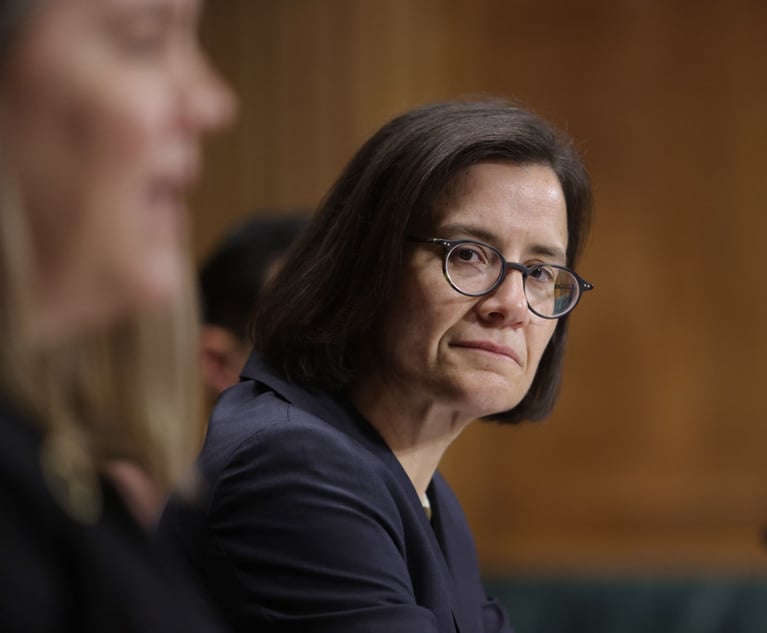Skilled in the Art: The Patron Saint of Lost PTAB Causes Strikes Again
Rob Greenspoon played a key role in getting the Supreme Court to review the constitutionality of IPRs. Now he's advancing a new attack.
February 27, 2018 at 09:00 PM
8 minute read
Welcome to Skilled in the Art. I'm Law.com IP reporter Scott Graham, and this week I'm writing about moonshots. One involves NantKwest's search for a cancer cure, the is other Rob Greenspoon's latest effort to rein in the Patent Trial and Appeal Board. As always, email me tips on anything IP and find me on Twitter @scottkgraham.
➤➤ Want to receive Skilled in the Art straight to your in-box? Sign up now.
Should an Appeal Mark the End of an IPR?
I used to think of Rob Greenspoon as the patron saint of lost PTAB causes. Then he helped get the Supreme Court's attention on the constitutionality of IPRs.
The Flachsbart & Greenspoon partner was one of the first lawyers to advance the case against constitutionality. He argued it at the PTAB, in district court, he even got the Fourth Circuit to schedule a hearing (later moved to the Federal Circuit). But eventually, Greenspoon played a key role in getting three judges of the Federal Circuit to say that the issue was important enough to consider en banc. And—what do you know?—the Supreme Court took up the issue in Oil States three weeks later.
Now Greenspoon is taking another home-run swing. MasterCardinvalidated his client's patent claims at the PTAB, so Greenspoon appealed to the Federal Circuit, and obtained a remand “for further proceedings.” The PTAB then canceled the patent claims a second time. But Greenspoon argues that by that point the America Invents Act's 18-month limit for conducting inter partes review had expired. The board no longer had jurisdiction to cancel the claims, remand or not, he says.
“Time was up. There was nothing left for the board to do, since it could not possibly meet the statutory deadline,” Greenspoon writes in D'Agostino v. MasterCard. He argues that Congress meant for IPRs to be “a 'one and done' process,” with no room for a second final written decision.
To prevail, Greenspoon will have to persuade the Federal Circuit (or the Supreme Court) that every time the PTAB has taken up an IPR on remand, it's been acting without jurisdiction. The PTAB typically needs a year to conduct IPR, and the Federal Circuit usually takes more than a year to decide an appeal. Nobody gets through the entire process in 18 months.
The solution is simple, Greenspoon says. The Federal Circuit either affirms or reverses the PTAB judgment on appeal. If there's not enough in the record for the appellate court to make a decision on some claims, then that part of the IPR is a nullity.
That's certainly a big ask. But the U.S. Patent and Trademark Office is taking the challenge seriously enough to intervene. The PTO argues in a brief filed last week that the AIA does not specifically prohibit the PTAB from proceeding after an appeal. “While the USPTO takes the timing requirement seriously, and would expect to hear about systemic failures to meet that timing requirement from a variety of sources, failure to comply with that requirement in any particular proceeding does not extinguish the board's jurisdiction,” the PTO states in a brief filed by Associate Solicitor Coke Morgan Stewart.
Stewart and the Baker Botts attorneys representing MasterCard point out that federal law empowers appellate courts to remand cases and “require such further proceedings to be had as may be just under the circumstances.”
MasterCard further argues that Greenspoon's client waived the argument by failing to make it before the PTAB on remand, and that even if there were any doubt about the 18-month limit, the Federal Circuit must defer to the PTO's interpretation of the AIA.
Greenspoon filed his reply brief today. He argues that jurisdiction can't be waived, that Chevron deference is inappropriate absent formal rulemaking, and that in PTAB cases, the “further proceedings” on remand are the PTO's publication of a certificate denoting claim cancellation or confirmation.
“No agency holds plenary authority to carry out an action just because its enabling enactment omits language prohibiting it,” Greenspoon writes, in whatsounds like a warmup for a cert petition. “Were courts to presume a delegation of power absent an express withholding of such power, agencies would enjoy virtually limitless hegemony.”
From Edison to Iancu
Honoring the inventors and directors who've preceded him, former Irell & Manella managing partner Andrei Iancu was formally sworn in Feb. 28 as USPTO director.
“Through these doors comes our future,” Iancu said at PTO headquarters in Alexandria. ”Through our examiners' hands will pass the cure to cancer. Before their eyes will come compounds that alleviate thirst and hunger. They will touch machines that transport humans to other planets, and they will handle processes that enable devices to think and create on their own.”
The PTO must “must endeavor to provide reliable, predictable and high-quality IP rights that give owners and the public alike, confidence in those rights,” he added.
Commerce Secretary Wilbur Ross introduced Iancu. On hand for the induction were former PTO leaders Q. Todd Dickinson, now of Polsinelli, and Gerald Mossinghoff, senior counsel at Oblon.
Who's Arguing?
Next week is a Federal Circuit calendar week, so instead of looking at “Who Got the Work?” I'm going to preview some of the prominent practitioners who'll be arguing high-stakes cases at the appellate court.
* ArcelorMittal v. AK Steel: Two steel industry giants will square off over a patent for using aluminum in the “hot stamping” of steel, a key to developing stronger auto body frames. Ohio-based AK Steel won summary judgment of non-infringement against ArcelorMittal, the world's largest steel producer. Sidley Austin appellate co-chair Constantine Trela will try to persuade CAFC that now-retired U.S. District Judge Sue Robinson was mistaken. Covington & Burling's Christopher Sipes will defend the judgment.
* Trustees of Columbia University v. Symantec: Columbia argues that the Patent Trial and Appeal Board misconstrued claims in two computer security patents. U.S. Patents 8,074,115 and 8,601,322 describe an “anomaly detector” that models normal behavior, recognizes attacks, and can be distributed across computers running the same program. Irell & Manella heavy hitter David Gindler will argue that the PTAB improperly canceled 59 challenged claims. Fenwick & West patent litigation chief Michael Sacksteder will try to make those rulings stick, while arguing that the PTAB should have gone further and canceled a handful more claims.
* NantKwest v. Iancu. On the job one week and already being sued? Such is the life of federal agency chiefs. Iancu's former law firm, Irell, and billionaire Patrick Soon-Shiong's cancer therapeutics company NantKwest are trying to avoid paying $78,000 in attorneys fees to the PTO following a failed district court challenge to the denial of a patent. Section 145 of the Patent Act provides that the patent applicant must pay “all of the expenses” of the district court proceeding regardless of outcome. A three-judge panel of the Federal Circuit ruled in June that means not only the PTO's expert fees, but also its attorneys fees. Irell legend Morgan Chu will argue to the en banc Federal Circuit that Section 145 is not sufficiently explicit to overcome the American rule against fee shifting. DOJ attorney Jaynie Lilley will argue for the PTO.
You Ought to Blog in Pictures
Law has long been fertile ground for blogging. From Scotusblog to the Volokh Conspiracy to IP's Patently-O and IP Watchdog, law blogs (I hate saying “blawgs”) have been an invaluable resource for news and thought leadership.
Now Shook Hardy & Bacon is starting a design law blog. But instead of telling us about design patents, 2Wit Design is going to show us. For example, what was it U.S. District Judge Lucy Koh wrote in her order about the “article of manufacture” last fall? Oh yes, here is is:

If you must have the ruling in words, they've got that too.
Shook Hardy partner Andy O'Brien calls it an “anti-blawg approach.” The goal is to avoid legalese and footnotes, he said in a press release announcing the blog. Instead 2Wit Design “harnesses the impact of great design to educate readers and clients about the laws designed to protect those assets.”
In closing, whether you prefer to learn visually or through the printed word, I hope you have a great evening and I'll see you again on Friday.
This content has been archived. It is available through our partners, LexisNexis® and Bloomberg Law.
To view this content, please continue to their sites.
Not a Lexis Subscriber?
Subscribe Now
Not a Bloomberg Law Subscriber?
Subscribe Now
NOT FOR REPRINT
© 2025 ALM Global, LLC, All Rights Reserved. Request academic re-use from www.copyright.com. All other uses, submit a request to [email protected]. For more information visit Asset & Logo Licensing.
You Might Like
View All
Global Lawyer: Big Law Walks a Tightrope But Herbert Smith Freehills Refuses to Lose Its Footing
8 minute readTrending Stories
Who Got The Work
J. Brugh Lower of Gibbons has entered an appearance for industrial equipment supplier Devco Corporation in a pending trademark infringement lawsuit. The suit, accusing the defendant of selling knock-off Graco products, was filed Dec. 18 in New Jersey District Court by Rivkin Radler on behalf of Graco Inc. and Graco Minnesota. The case, assigned to U.S. District Judge Zahid N. Quraishi, is 3:24-cv-11294, Graco Inc. et al v. Devco Corporation.
Who Got The Work
Rebecca Maller-Stein and Kent A. Yalowitz of Arnold & Porter Kaye Scholer have entered their appearances for Hanaco Venture Capital and its executives, Lior Prosor and David Frankel, in a pending securities lawsuit. The action, filed on Dec. 24 in New York Southern District Court by Zell, Aron & Co. on behalf of Goldeneye Advisors, accuses the defendants of negligently and fraudulently managing the plaintiff's $1 million investment. The case, assigned to U.S. District Judge Vernon S. Broderick, is 1:24-cv-09918, Goldeneye Advisors, LLC v. Hanaco Venture Capital, Ltd. et al.
Who Got The Work
Attorneys from A&O Shearman has stepped in as defense counsel for Toronto-Dominion Bank and other defendants in a pending securities class action. The suit, filed Dec. 11 in New York Southern District Court by Bleichmar Fonti & Auld, accuses the defendants of concealing the bank's 'pervasive' deficiencies in regards to its compliance with the Bank Secrecy Act and the quality of its anti-money laundering controls. The case, assigned to U.S. District Judge Arun Subramanian, is 1:24-cv-09445, Gonzalez v. The Toronto-Dominion Bank et al.
Who Got The Work
Crown Castle International, a Pennsylvania company providing shared communications infrastructure, has turned to Luke D. Wolf of Gordon Rees Scully Mansukhani to fend off a pending breach-of-contract lawsuit. The court action, filed Nov. 25 in Michigan Eastern District Court by Hooper Hathaway PC on behalf of The Town Residences LLC, accuses Crown Castle of failing to transfer approximately $30,000 in utility payments from T-Mobile in breach of a roof-top lease and assignment agreement. The case, assigned to U.S. District Judge Susan K. Declercq, is 2:24-cv-13131, The Town Residences LLC v. T-Mobile US, Inc. et al.
Who Got The Work
Wilfred P. Coronato and Daniel M. Schwartz of McCarter & English have stepped in as defense counsel to Electrolux Home Products Inc. in a pending product liability lawsuit. The court action, filed Nov. 26 in New York Eastern District Court by Poulos Lopiccolo PC and Nagel Rice LLP on behalf of David Stern, alleges that the defendant's refrigerators’ drawers and shelving repeatedly break and fall apart within months after purchase. The case, assigned to U.S. District Judge Joan M. Azrack, is 2:24-cv-08204, Stern v. Electrolux Home Products, Inc.
Featured Firms
Law Offices of Gary Martin Hays & Associates, P.C.
(470) 294-1674
Law Offices of Mark E. Salomone
(857) 444-6468
Smith & Hassler
(713) 739-1250












